
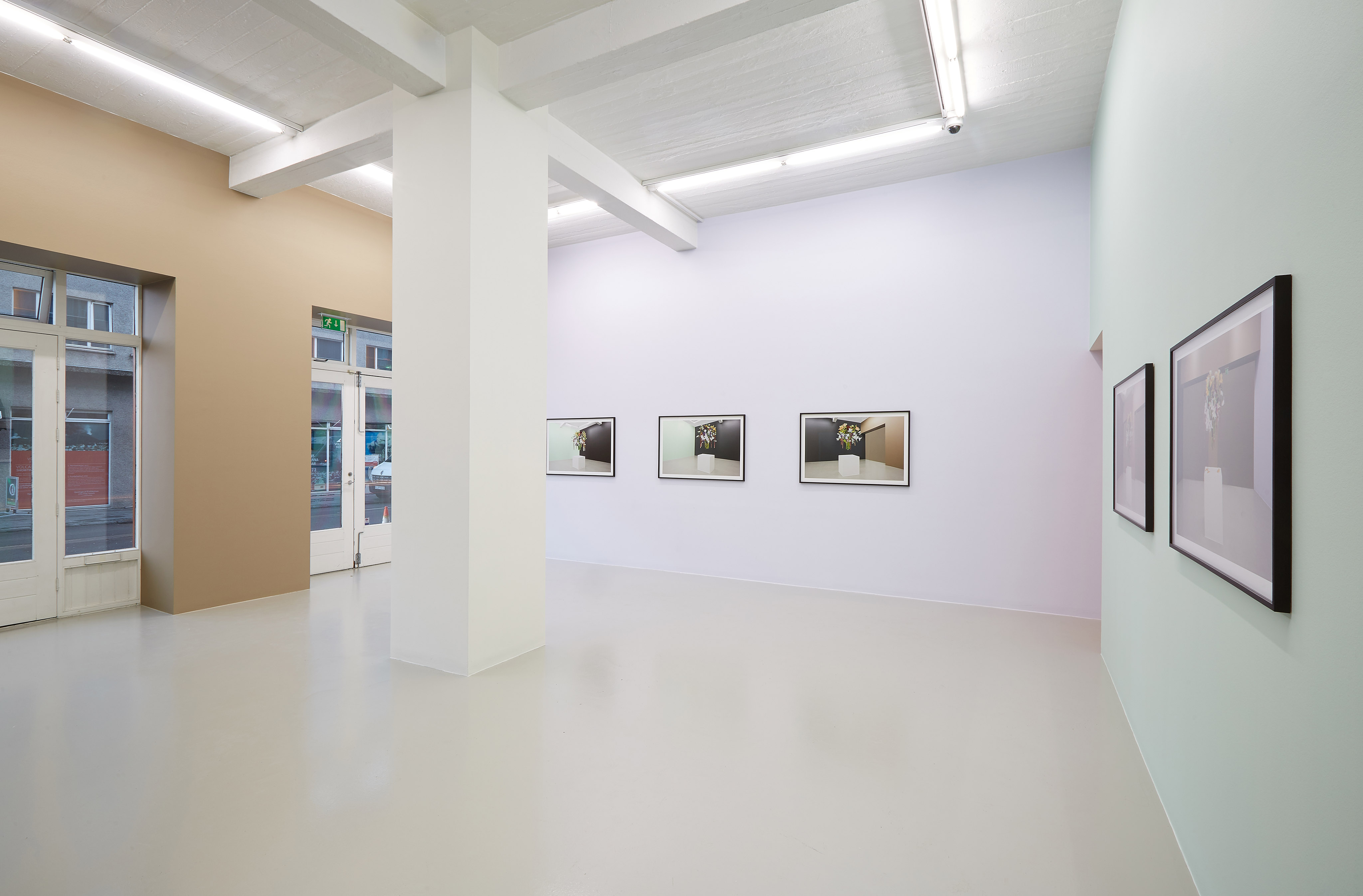


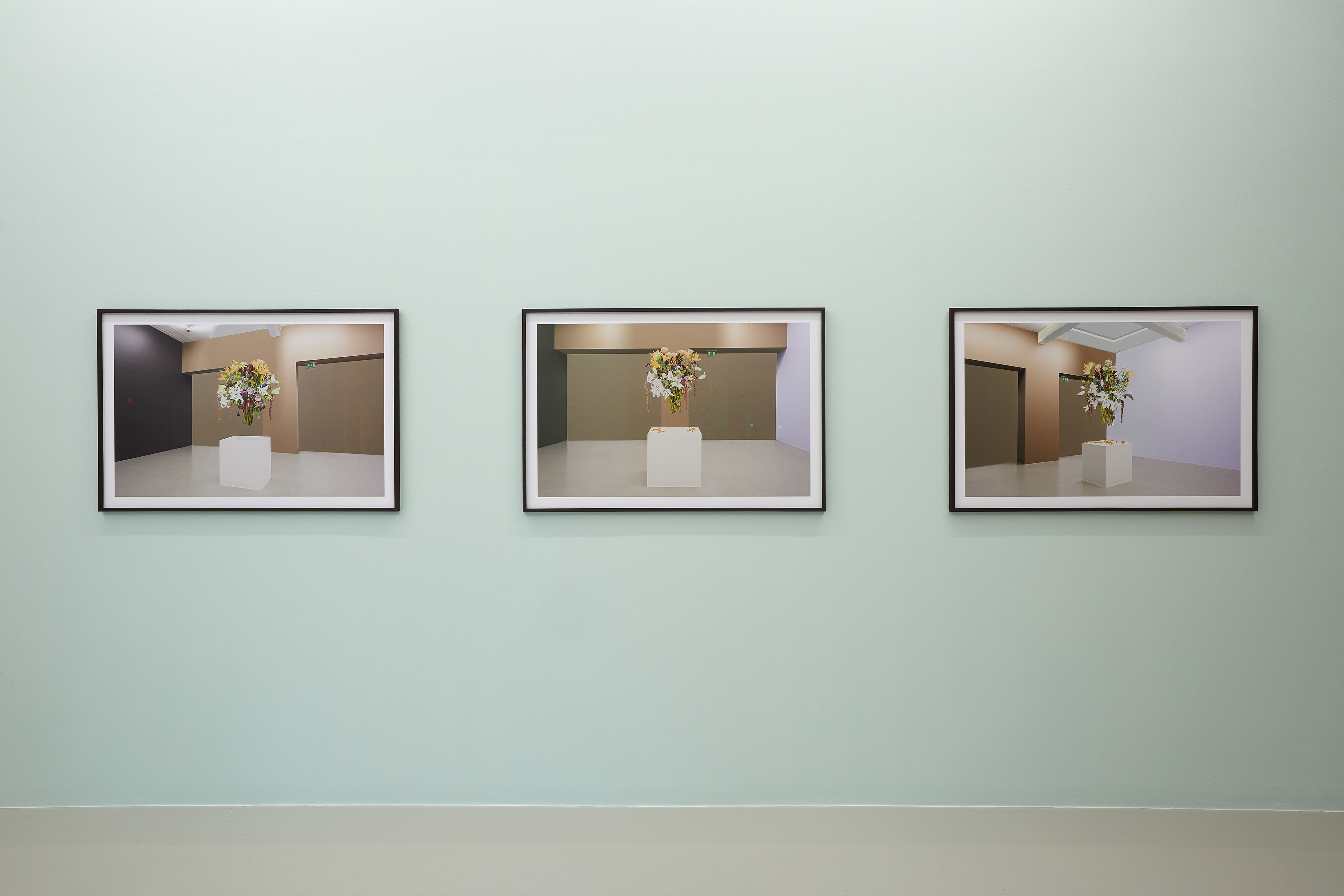
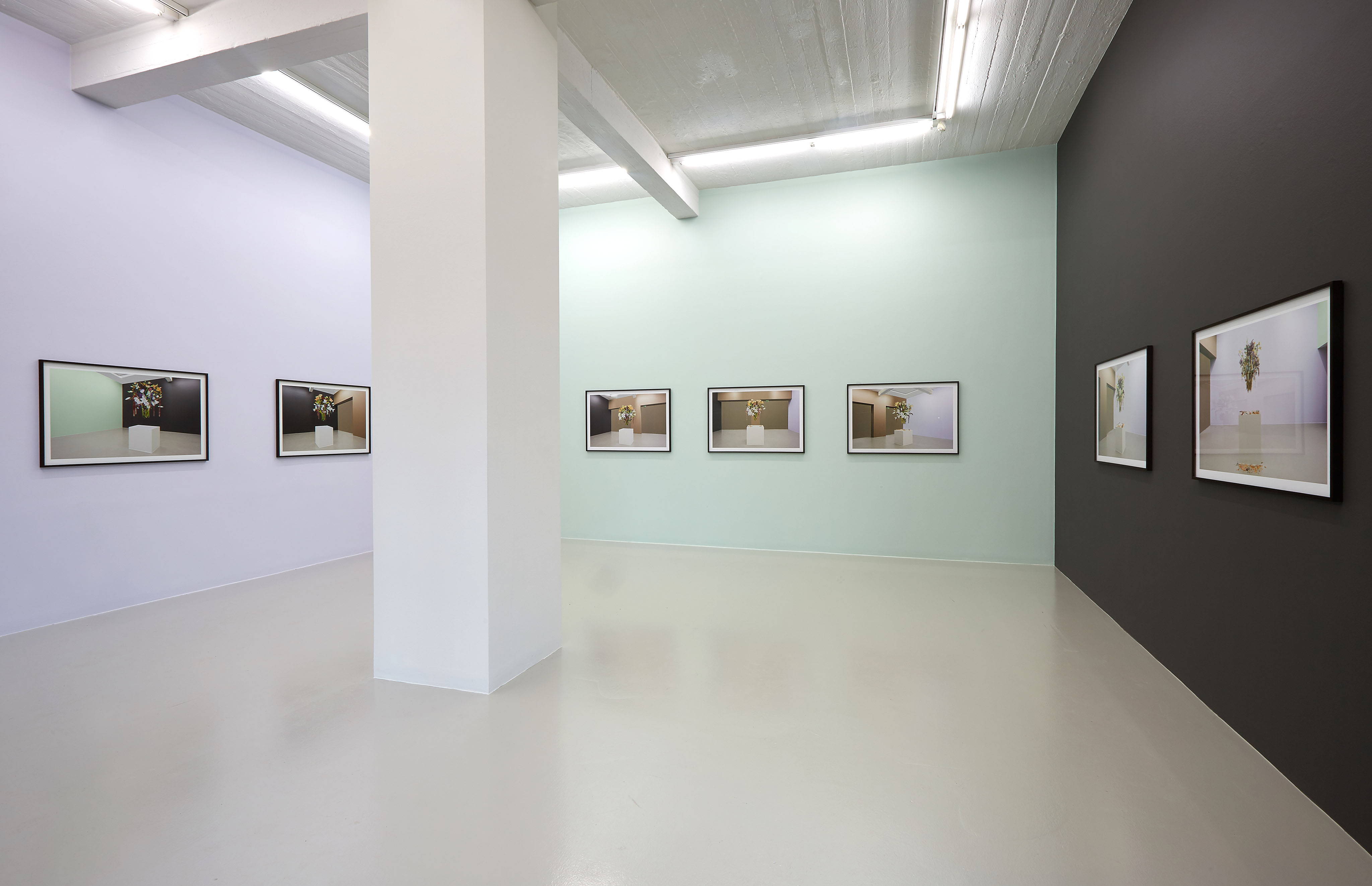
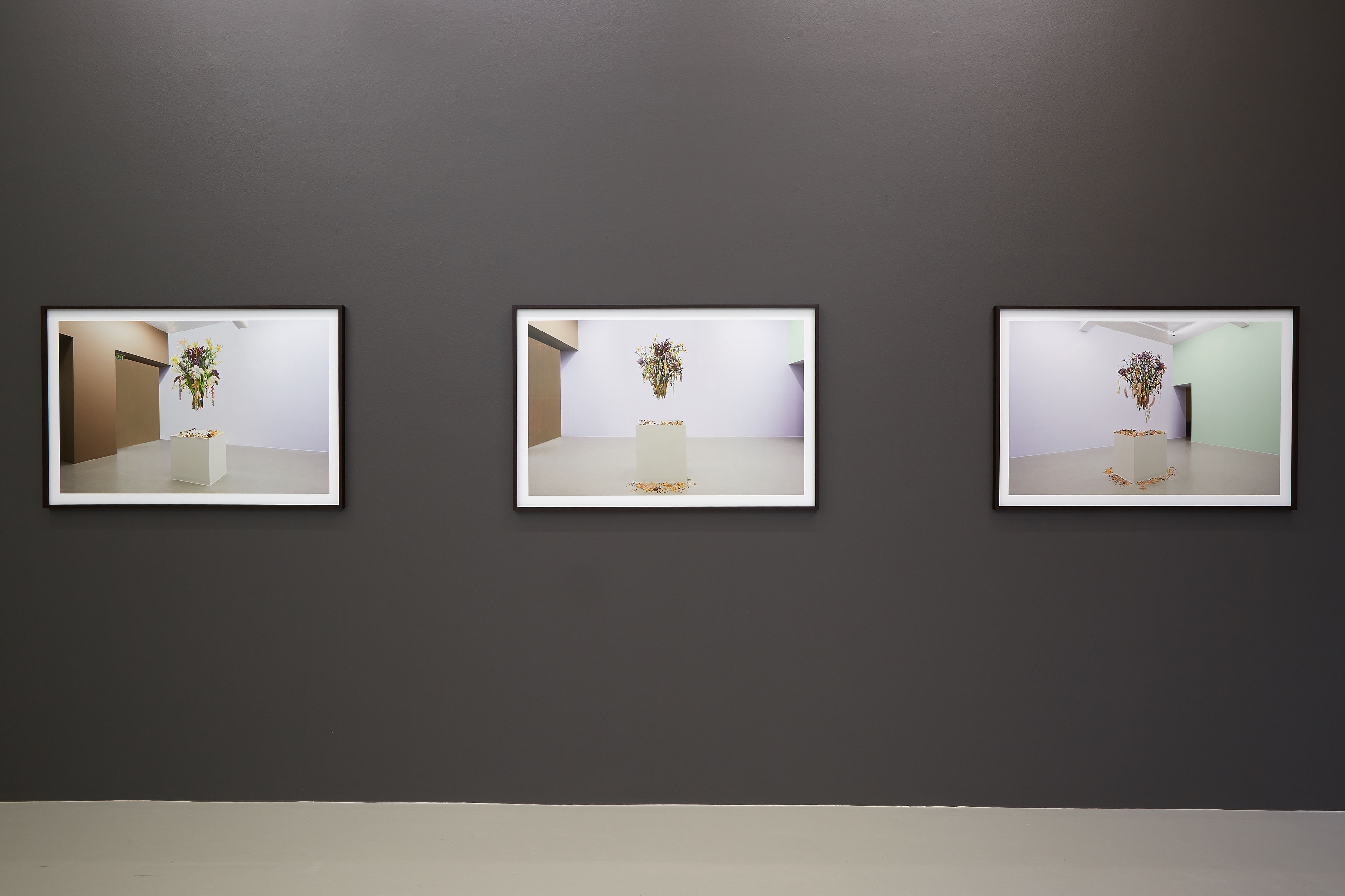


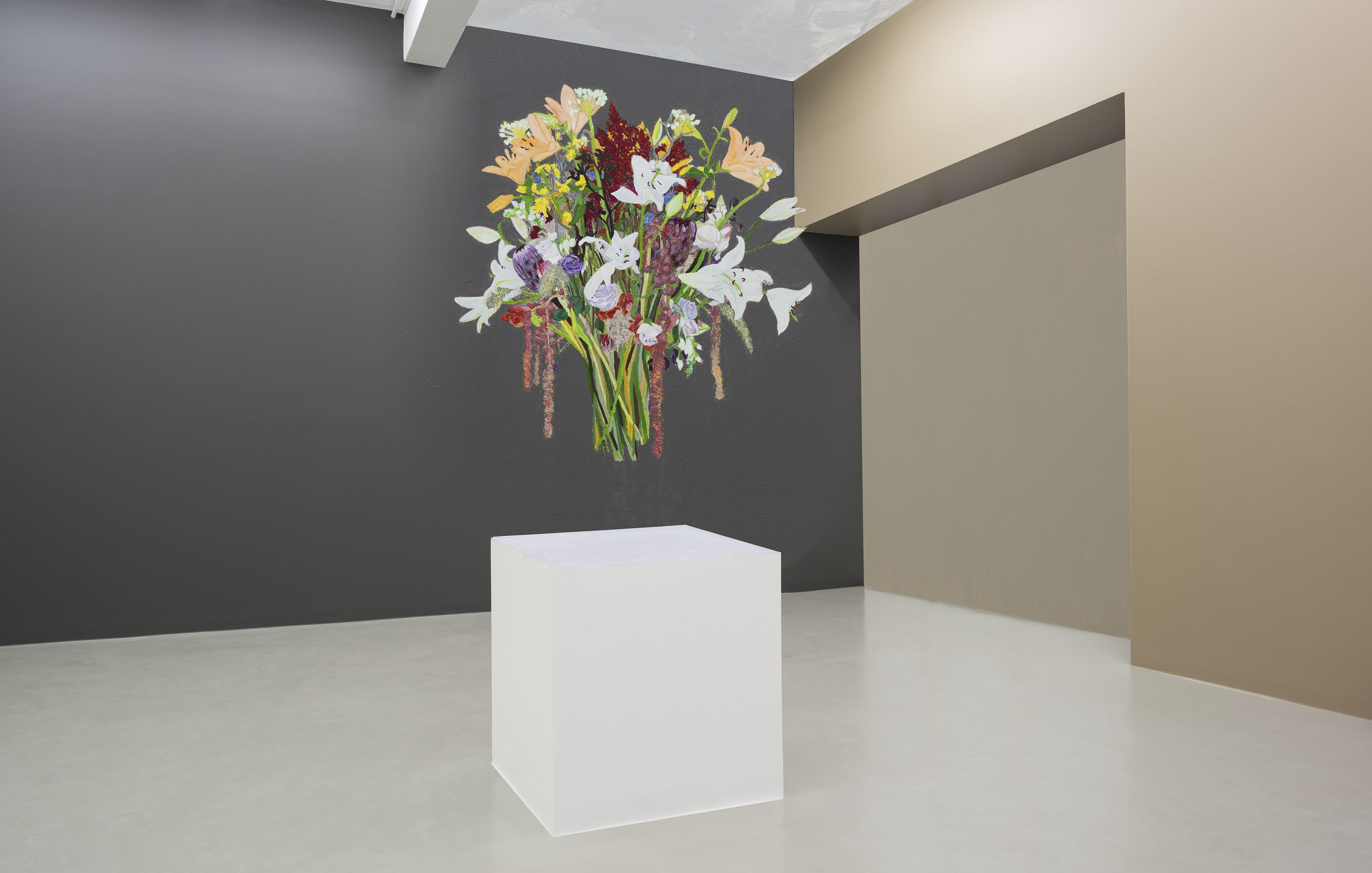
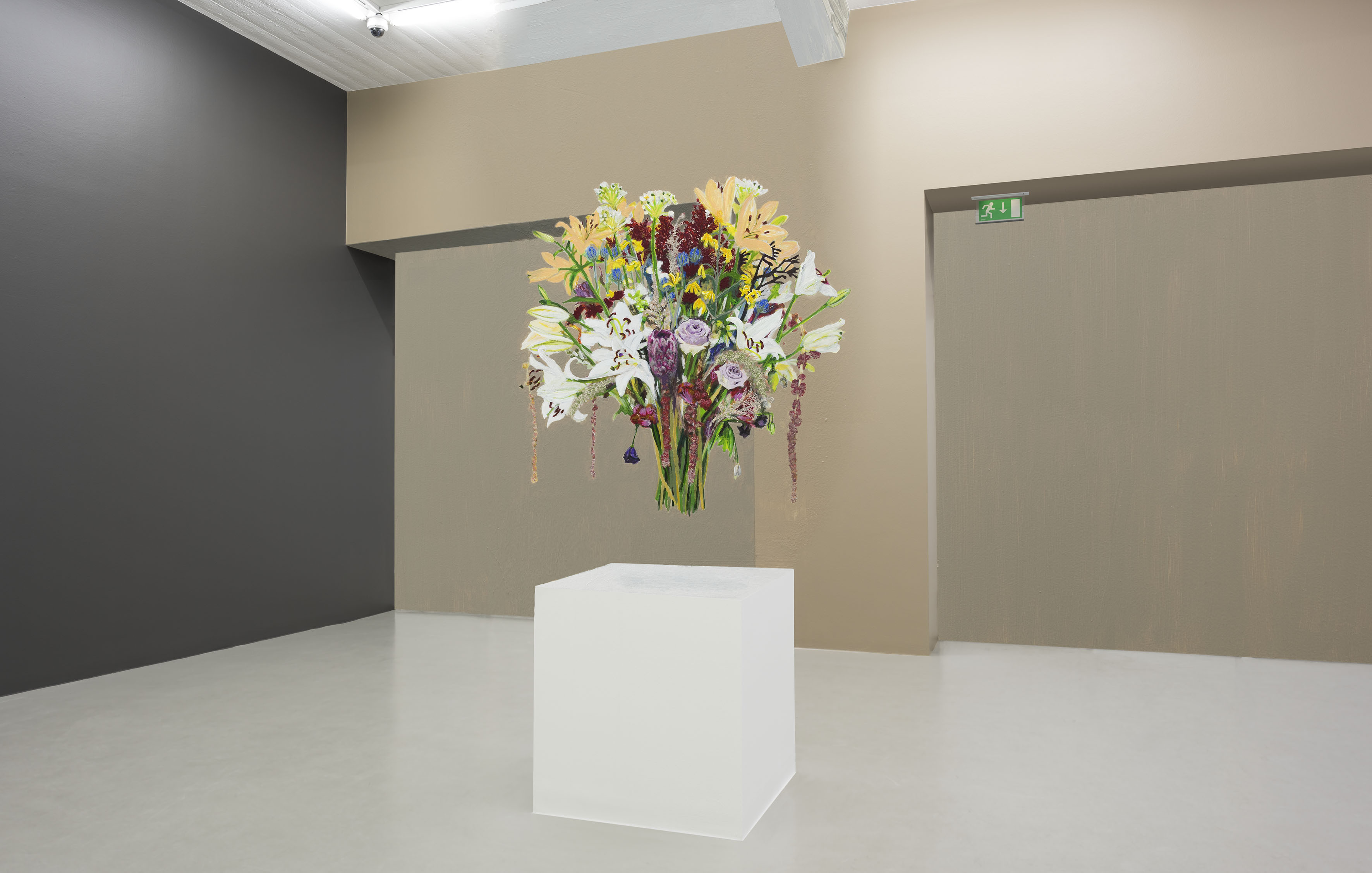




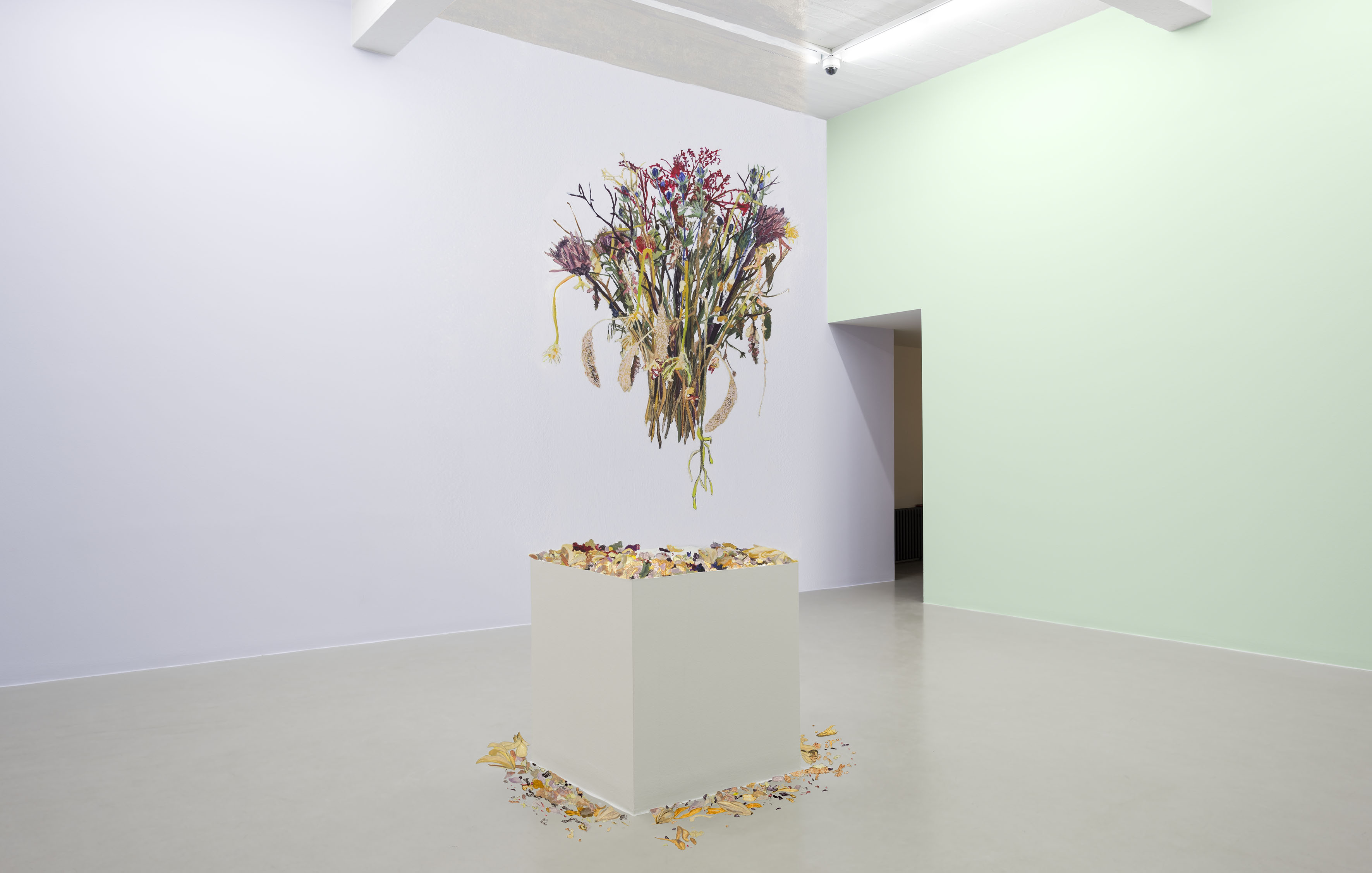
SIMULACRA
2016
9 archival inkjet prints shot through glass-matte paintings
i8 Gallery Reykjavík, Iceland
2016
9 archival inkjet prints shot through glass-matte paintings
i8 Gallery Reykjavík, Iceland
SIMULACRA is a photographic installation that explores perception, illusion, and spatial memory through the use of an early cinematic technique known as glass-matte painting. In this work, a hyperreal element is introduced into an otherwise empty exhibition space.
Over a three-week period in the studio, a wilting bouquet of flowers was photographed from nine different perspectives. Each of these views was then meticulously painted onto individual sheets of glass, using the traditional matte painting technique once employed in early film production to blend real and fictional elements with a single frame.
These nine glass panels were later transported to the gallery space, where they were positioned in front of the camera, replacing the central architectural column with the illusion of a hovering, time-shifting bouquet. The resulting photographs - seemingly simple still lives - reveal a subtle but powerful visual trick: the real structure of the space is concealed, and replaced by a hand-painted fiction.
A key tension in SIMULACRA lies in the contrast between the lo-fi texture of the hand-painted glass mattes and the crisp, hyper-detailed nature of modern high-resolution photography. The soft brushwork, visible imperfections, and materiality of the painted surface are magnified throught he lens, creating an uncanny visual effect - at once painterly and photographic, tactile and digitally precise. This clash of mediums amplifies the illusion while simultaneously revealing its construction, drawing the viewer deeper into a perceptual space where truth and artifice become insperable.
By collapsing time and space into a single photographic frame, SIMULACRA challenges the viewer´s trust in the visual evidence and draws attention to the constructed nature of perception. The floating bouquet, suspended between presence and absence, becomes a poetic stand-in for the unseen - and for the way we will voids with memory, imagination or illusion.
Over a three-week period in the studio, a wilting bouquet of flowers was photographed from nine different perspectives. Each of these views was then meticulously painted onto individual sheets of glass, using the traditional matte painting technique once employed in early film production to blend real and fictional elements with a single frame.
These nine glass panels were later transported to the gallery space, where they were positioned in front of the camera, replacing the central architectural column with the illusion of a hovering, time-shifting bouquet. The resulting photographs - seemingly simple still lives - reveal a subtle but powerful visual trick: the real structure of the space is concealed, and replaced by a hand-painted fiction.
A key tension in SIMULACRA lies in the contrast between the lo-fi texture of the hand-painted glass mattes and the crisp, hyper-detailed nature of modern high-resolution photography. The soft brushwork, visible imperfections, and materiality of the painted surface are magnified throught he lens, creating an uncanny visual effect - at once painterly and photographic, tactile and digitally precise. This clash of mediums amplifies the illusion while simultaneously revealing its construction, drawing the viewer deeper into a perceptual space where truth and artifice become insperable.
By collapsing time and space into a single photographic frame, SIMULACRA challenges the viewer´s trust in the visual evidence and draws attention to the constructed nature of perception. The floating bouquet, suspended between presence and absence, becomes a poetic stand-in for the unseen - and for the way we will voids with memory, imagination or illusion.
Exhibition text by
Dore Bowen, PhD
Dore Bowen, PhD
In Simulacra, an installation at i8 gallery from December 8th 2016 through February 4th 2017, Icelandic artist Elín Hansdóttir radically alters the gallery space and then returns it to its original state with only photographs serving as evidence. When viewers enter the gallery they see nine nearly identical photographs depicting a prosaic scene—a vase of flowers. Upon closer inspection, however, the scene becomes strange, as the flowers are depicted hovering in the center of the gallery where the building’s support column is located, literally defying gravity and logic. And as viewers scan one photograph after another the flowers seem to devolve from a state of bloom to death, as if a Dutch still painting has been divided into cells for a stop-motion animation film.
To create this illusion Hansdóttir used techniques derived from the early years of Hollywood cinema, which she innovated for her own purposes. In this installation she photographed a vase of flowers over two weeks and from these images painted glass mattes, which she installed around the gallery's column. The artist then photographed the column, which, courtesy of the matte paintings around it, seemed to disappear. The glass mattes were then removed. Upon entering the gallery viewers will anxiously look from the photographs on the wall to the site they depict, finding only a support column in the gallery but expecting more. Whether miracle or a trick, these photographs at i8 depict an event that interrupts the scene of normality, and such events, as Alain Badiou notes, reveal the multiplicity that lies at the foundation of reality, shaking our sense of continuity.
As in prior installations by this artist the viewer serves as a catalyst. In Trace (2010), for example, viewers scan the wall like a film projector, piecing together still images into a coherent narrative. Similarly, in Path (2008) viewers walk down a corridor as they attempt to assemble a host of discrete and ungrounded experiences into a phenomenological whole. And in Suspension of Disbelief (2015) Hansdóttir introduces the glass matte technique, thereby obliging viewers to composite installation with representational imagery. While she continues in this manner Simulacra is more about time than space. It is also more layered and more explicitly about history. It thus compels viewers to do a different kind of work than her previous installations do. If un lieu de mémoire is a spatial marker indicating a mnemonic absence, this installation comes at the problem of memory from multiple angles. The artist’s layered process serves as an index to the different rhythms that once infused daily life—the quick clip of stop-motion cinema, the languorous stillness of the still life painting, the “decisive moment” of photography, and the timelessness of religious symbolism. Conversely, these invoked rhythms suggest that the contemporary gallery—with its white walls, sheetrock dividers, cement floor, and central support column—buries memory. Such memories reemerge in Simulacra uninvited.
To create this illusion Hansdóttir used techniques derived from the early years of Hollywood cinema, which she innovated for her own purposes. In this installation she photographed a vase of flowers over two weeks and from these images painted glass mattes, which she installed around the gallery's column. The artist then photographed the column, which, courtesy of the matte paintings around it, seemed to disappear. The glass mattes were then removed. Upon entering the gallery viewers will anxiously look from the photographs on the wall to the site they depict, finding only a support column in the gallery but expecting more. Whether miracle or a trick, these photographs at i8 depict an event that interrupts the scene of normality, and such events, as Alain Badiou notes, reveal the multiplicity that lies at the foundation of reality, shaking our sense of continuity.
As in prior installations by this artist the viewer serves as a catalyst. In Trace (2010), for example, viewers scan the wall like a film projector, piecing together still images into a coherent narrative. Similarly, in Path (2008) viewers walk down a corridor as they attempt to assemble a host of discrete and ungrounded experiences into a phenomenological whole. And in Suspension of Disbelief (2015) Hansdóttir introduces the glass matte technique, thereby obliging viewers to composite installation with representational imagery. While she continues in this manner Simulacra is more about time than space. It is also more layered and more explicitly about history. It thus compels viewers to do a different kind of work than her previous installations do. If un lieu de mémoire is a spatial marker indicating a mnemonic absence, this installation comes at the problem of memory from multiple angles. The artist’s layered process serves as an index to the different rhythms that once infused daily life—the quick clip of stop-motion cinema, the languorous stillness of the still life painting, the “decisive moment” of photography, and the timelessness of religious symbolism. Conversely, these invoked rhythms suggest that the contemporary gallery—with its white walls, sheetrock dividers, cement floor, and central support column—buries memory. Such memories reemerge in Simulacra uninvited.